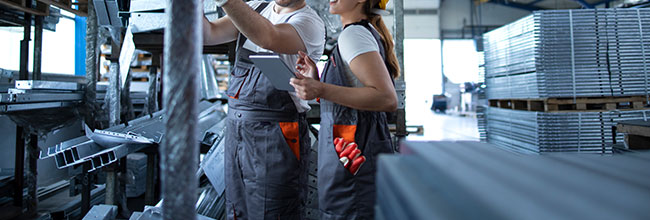Asbestos has been used by humanity for millennia in a variety of applications. However, the process and development of asbestos use have taken many turns and seen many innovations before the regulation and bans in America in the late 20th century. Because of this, it’s worthwhile to step back and consider the status and use of asbestos in the 1800s. During this time, we’ll see some of the essential trends that led to the explosion of asbestos use in the 19th and 20th centuries.
The long and sordid history of asbestos use around the world.
| Asbestos is highly resistant to heat, pressure and corrosion, so it was used in many products, vehicles and buildings. In particular, many workplaces like factories, refineries, foundries and shipyards involve high amounts of heat, and were built with a lot of asbestos. | |||
  |   |   |   |
The Backdrop of 1800s Asbestos
It’s important to start by asking the fundamental question: what exactly is asbestos? It may surprise you to learn that asbestos is actually a term to describe several different things. In fact, asbestos is an umbrella term used to describe a group of various silicate minerals that occur naturally in the earth. Today, the term asbestos is used interchangeably to refer to six different kinds of asbestos that make up either the serpentine or amphibole groups of asbestos. These two terms are given to describe the shape of asbestos fibers, either curly (serpentine) or needle-like (amphibole).
“Some asbestos fibers may bypass…your body’s natural defenses…and lodge deep within your lungs. Those fibers can remain in place for a very long time and may never be removed.”Source: American Lung Association |
Ancient Uses of Asbestos
While the ancient Greek term “asbestos” (meaning indestructible) was coined and popularized only a few hundred years ago, the understanding of asbestos and its durable qualities was well-known by ancient cultures. For example, during the Stone Age, the ancient Kiukainen culture in the region of Finland used asbestos fibers for design elements in decorative pottery. Other cultures, including Egyptian, Roman, and Chinese used asbestos for things like shrouds, lamp wicks, and cloth.
People who worked in these industries prior the mid-1980s have a higher risk of developing asbestos-related diseases:
| Construction | Factories | Foundries | Refineries | Shipyards | Mining / Milling |
| Demolition | Insulation | Steelworkers | Pipe Fitting | Shipbuilding | Mechanics |
  |   |   | |||
| Roofing | Textiles | Iron workers | Boilers | Firefighting | Brake Repair |
| Flooring | Cement | Electricians | Gasket Repair | Railroad | HVAC |
Unfortunately so do their families.
The Booming of Asbestos in the 1800s
Besides some of these well-known applications of asbestos, it seems that the full potential of asbestos was under-realized in the centuries prior to the 1800s. This does not mean that asbestos was not used, but it seemed to remain a regional phenomenon for cultures located close to asbestos deposits. Moreover, asbestos was more commonly used in small-scale everyday applications like pottery; the large-scale asbestos production industry we know of today was not yet up and running, but it was quickly coming into view.
“All forms of asbestos are carcinogenic to humans.” 1
International Mining Efforts and the Asbestos Industry
In the 19th and 20th century, industrialists were on the hunt for asbestos mines around the world.
During the 1800s, companies began to realize the widespread possibilities of establishing asbestos mines as a way to harvest asbestos fibers for various manufacturing applications. These mines began to be established worldwide, especially throughout Canada, Italy, and various countries throughout South Africa.
The use of asbestos in the textile industry signaled the pivot of the mineral into its incredible economic importance we are familiar with today. The story is said to start with Italy’s patented development of asbestos thread (spinning, weaving, twisting) in the late 1860s.
Sharing a home or vehicle with someone wearing asbestos-tainted clothing puts you at risk of asbestos-related diseases. 2
The Industrial Revolution was an Asbestos Revolution
It’s not so much this process itself, but the chain reaction of different countries in the following years that really situated asbestos at the heart of the Industrial Revolution. The reason for this is that the shift from hand to machine manufacturing required the need to maintain and protect machines from their intensive manufacturing processes. In other words, machinery, piping, and other components require protection from high heat and fire.
“Generally, those who develop asbestos-related diseases show no signs of illness for a long time after exposure.”Source: National Cancer Institute (NIH)3 |
Paving the Way for the Construction Industry
The solution was asbestos, and one of the first industrial examples of this was the use of asbestos to heat-proof steam boilers. This protected machinery from getting too hot, but asbestos was also used to wrap the piping systems of boilers in order to keep water hot. This paved the way for using asbestos in insulation for attics and plumbing later on in the construction industry, as the early usage of asbestos in boiler systems proved the incredible insulating qualities of the mineral.
  |
| Nearly every building constructed before the mid-1980s contained asbestos products and building materials. |
  |
Not only did the circumstance of asbestos mining efforts provide the ability to supply Industrial sites with a fireproofing material to keep their machines running around the clock but the Industrial Revolution also meant that manufacturing technology now existed for asbestos-containing materials.
This marked the shift from using asbestos in small-scale utility applications like pottery and cloth to high-yield applications like construction and machinery insulation. Asbestos quickly shifted from a primitive resource to an industry-standard in the majority of manufacturing applications.
Asbestos has no taste or smell.
You may not know you’re breathing it.


Africa: The Source of the UK’s Asbestos Industrialism
Turner & Newall – an early asbestos manufacturer
Some of the more popular companies found a way to get into the asbestos industry while it was still a niche industry by staking a claim in South Africa. Turner and Newall, a British company, is one example of this. Founded in 1871, T&N became a key source of asbestos manufacturing, with trades including boilermakers, ironworkers, steamfitters, pipefitters, insulators, steel workers, and factory laborers. The company saw widespread demand in the late 1800s and early 1900s, eventually leading to T&N’s purchase of South African land in order to establish an asbestos mining facility. Part of this availability had to do with Britain’s involvement in the colonization of South Africa, and the influence of asbestos was so widespread that even a $10 Bill from the Central Bank of Swaziland once displayed the asbestos mine that was so central to the economy of that region.
Do You Qualify For Compensation?
Quickly and easily find out how you were exposed by searching W.A.R.D., the largest asbestos database on the planet.
FREE SEARCH >Henry the Innovator
Johns Manville: The world’s largest asbestos company
One of the most famous (and infamous) companies in asbestos history is Johns-Manville. This company began in the late 1850s with Henry Ward John’s first patented product, asbestos roofing shingles. Ironically, Henry died from what is now believed to be the lung disease asbestosis in 1901, making him one of the first victims of the asbestos-containing products associated with Johns-Manville in the coming decades.
Perhaps ironically – Henry Johns, founder of the world’s largest asbestos company, died of asbestosis.
Along with the first success of shingles, JM eventually became one of the industry standards for boiler wraps and other asbestos applications that were being popularized in the 1800s.
“Some asbestos fibers may bypass…your body’s natural defenses…and lodge deep within your lungs. Those fibers can remain in place for a very long time and may never be removed.”Source: American Lung Association |
Asbestos in Canada
The final important piece in the makings of asbestos’ widespread popularity in the 20th century has to do with the discovery of asbestos in Quebec Canada. This discovery in 1860 led to mining efforts in 1878 at Thetford Mines. While asbestos operations in Canada have since declined within the era of various national bans, Quebec continues to serve as a mining site in the industry.


Health problems associated with asbestos (it is a carcinogen).
The health risks of asbestos exposure can include:
| Mesothelioma: cancer of the mesothelium, the thin layer of tissue surrounding the body’s organs. This cancer is only known to be caused by asbestos exposure. | Lung cancer |
| Laryngeal cancer: cancer of the larynx (section of the throat called the voicebox) | Ovarian cancer |
| Stomach cancer | Colon cancer |
| Pharyngeal cancer | Asbestosis: a chronic lung disease associated with asbestos exposure |
| Chronic Obstructive Pulmonary Disease (COPD) | Atelectasis (collapsed lung) |
| Pleural effusion (collection of fluid around the lungs) | Pericardial effusion (collection of fluid around the heart) |
Compensation is available for asbestos exposure.
Lessons to learn from the history of asbestos in the 1800s
While these examples of asbestos in the 1800s may seem like unrelated facts, it is important to consider them from a bird’s eye view. Together, they tell the story of how patenting, mining discoveries and the innovations of the Industrial Revolution paved the way for an explosive wave of production across the world.
Going into the 1900s, no longer would asbestos be considered a niche industry or a cultural icon. Instead, it would become the industry standard in construction and manufacturing, making it a notorious material in homes, schools, and workplaces.
| Asbestos causes cancer. Health researchers are learning how. Studies show that asbestos fibers embed in the bodily tissue:
|
Unfortunately, this wave of supply and demand of asbestos made possible by the discoveries and innovations of the 1800s would outpace the supply of medical research. The same companies that made fortunes from the asbestos industry were well aware of the dangers posed to their workers and their customers.
Unfortunately, this information was ignored and suppressed for much of the 20th century. Thousands who suffer from asbestos-related diseases today can still benefit from the bankruptcy trust funds established by these defunct industry leaders, but the damage has been done.
Over $30 Billion is still available (No lawsuit. No fees unless you receive money. No risk.) Stake your claim.   |
The Miracle Mineral / The Monster Mineral
Many of the once-thriving asbestos mining sites have been dismantled or remain in ruins, but they represent a peculiar era of human history that was only made possible by the fascinating chain of events that took place in the 1800s.
AsbestosClaims.Law
At AsbestosClaims.Law, our mission to secure compensation for asbestos victims is more than professional; it’s personal.
Our founder, Justinian C. Lane, understands the devastating impacts of asbestos firsthand.
Both his grandparents and father, all asbestos workers, passed away from asbestos-induced cancers without realizing their eligibility for asbestos lawsuits or other forms of compensation.
We aim to prevent such tragic oversights by informing and guiding victims and their families through their legal options.
If you or your loved ones have suffered as a result of asbestos exposure, you could be eligible for considerable compensation. These funds could provide for medical treatments, asbestos removal services, and safeguard your health.
In addition, asbestos trusts offer compensation without the need for a lawsuit, providing a quicker, simpler path to justice.
Reach out to us at [email protected] or (206) 455-9190 for assistance with your claim. We offer compassionate listening, clear explanations, and we don’t charge a dime unless we win your case.
Beyond legal claims, we also advise on veterans’ disability, social security, and employment protection like workers’ compensation, FELA, and The Jones Act for maritime workers.
There’s no risk or cost to connect with our experienced team about your rights. Our commitment to your well-being means no fees unless you receive compensation.
| For further queries or concerns about asbestos, explore our website and YouTube page, featuring infographics, videos, and answers to common questions on asbestos-related topics. |
We’ve also introduced W.A.R.D., the Worldwide Asbestos Research Database. It’s the most comprehensive resource for asbestos-related information.
W.A.R.D. assists in pinpointing potential exposure scenarios, asbestos-containing products, and can indicate the types and potential amounts of compensation you may be entitled to receive.
1 IARC Working Group on the Evaluation of Carcinogenic Risks to Humans. Arsenic, metals, fibres, and dusts. IARC Monographs on the Evaluation of Carcinogenic Risks to Humans. 2012 ;100(Pt C):11-465. PMID: 23189751.
2 Anua, S.M., Semple, S., Shakri, S.F.M., Safuan, S., Mazlan, N. and Asri, A.A.M., 2019. A review of the take-home exposure pathway of workplace hazards. International Journal of Medical Toxicology & Legal Medicine, 22(3and4), pp.13-19.
3 National Cancer Institute (NIH), Asbestos Fact Sheet.




